This book was sent to me by the publisher, Allen&Unwin, at no cost. The RRP is $39.99 and it’s available  from today (May 25).
from today (May 25).
Recipes I’ve tried
Potato and celery salad with celery leaf pesto
My darling isn’t a huge fan of basil pesto, as a rule, so I was curious to see how he felt about this one. It’s made with the inner celery leaves (the yellowy ones), parsley, capers, pine nuts and pecorino (I used parmesan) plus the other normal pesto bits. And the answer was that he really liked it – as did I. It’s a lot subtler than basil pesto (which I do love), but still very tasty. This recipe puts the pesto with boiled potatoes and inner celery stems. I served it with those and chicken, and ate the leftover chicken with leftover pesto the next day. Very nice.
Baked spicy cauliflower, chickpeas and fresh dates
First change: no fresh dates, so used dried ones. Anyway – cauliflower with cumin and coriander and garam masala, baked; always lovely. Cook onion and add chickpeas, then throw those on top of the cauli and add the tahini which you’ve mixed with orange juice and zest and a bit of sweet. I served this by itself but would definitely make it again to serve with other salads. Very tasty and I enjoyed the mouthfeel of cauli with tahini. I suspect this may become a favourite pairing.
Pocket pie: moroccan-spiced pumpkin, silver beet and goat’s cheese
Look, it’s fair to say that this recipe caused some anguish. This is probably largely on me, because Blereau’s recipe calls for shortcrust pastry to be made from spelt and barley flour, but the two places I tried – the supermarket (I live in a hipster and immigrant area, so it’s not that ridiculous) and a bulk-food place – did not have barley flour. So I subbed in ordinary flour. I did not do the research into whether or how barley flour deals differently with butter compared with ordinary flour. The pastry was very short and I found it very difficult to deal with. There might have been some shouting. Still, with the soothing hands of my beloved we did end up making them, and they were tasty enough; it seemed like a lot of butter, because they went very crispy. The filling was ok – roasted pumpkin with coriander, cumin, and fennel.
Split pea, fennel and winter vegetable soup
Again, neither of the places I checked had green split peas. The supermarket had a spot for them, but they were out of stock. So I used a normal soup mix. This is a very nice soup but it’s not anything out of the ordinary.
Creamy fresh corn polenta with refried black beans
I think I’ve made polenta maybe once, and that was to cut it up into squares and bake it (which was nice). This recipe recommends cooking the polenta in a fatty stock, and I realised that I had a lamb ‘stock’ in the freezer from ages ago – I think it was liquid I drained off some dish and couldn’t bear to throw. So I used that to cook the polenta, and it was delicious. The refried black beans were also really nice, with capsicum and coriander and a little too much chilli for my tastes (c/ beloved being a little heavy handed). We didn’t add the corn to this because we’re not huge fans; I didn’t think the dish suffered for its lack.
I ignored most of the section on ‘basics’, like using kefir grains in… stuff… and preparing and cooking beans, lentils, and grains.
The book itself
It’s a well presented book, as you’d expect from Allen&Unwin; it’s one of those big cookbooks, with what feels like a solid spine, and generally appetising photos throughout. Each recipe has dietary info about whether it’s dairy or gluten free, vego or vegan, and other allergy stuff. However the recipes, while nicely set out on the page, sacrifice font size in favour of white space, which makes reading from a distance something of a struggle – not great from the other side of the stove.
I have two main issues with the book. One is perhaps obvious from comments above: there are ingredients in here that were not easy for me to find. I do not know what kombucha or kefir grains are, nor where to find them. I live near the city, in a hipster area. Probably I could find these things, and I know I could find them online, but the point remains that this is not an easy, automatic book to cook from – and that’s not acknowledged anywhere, as far as I could find. Connected to this is the reality that this is not a book for the economically poor, nor the time poor. This is not necessarily a problem, if you’re buying for yourself and willing to put in the time and money, but it is something that should be acknowledged. Blereau is all in for pre-soaking beans and grains and then cooking for however long, so you need to be prepared for that if you want to follow the recipes precisely. And of course being prepared for the time it takes to make cultured cream and so on with your kefir grains.
And then there’s the wholefoods thing. I am not on the wholefoods bandwagon. I am all in favour of cooking food from scratch if you have the time, I understand some of the issues with overly processed stuff, and so on. But when I read the introduction to this book, I ended up getting out a pencil and making annotations in the margins because I got annoyed with it. For instance, there’s the suggestion that industrialisation of food in Australia started in the 1960s and 1970s, and grossly generalised statements about ‘traditional cultures’ that enjoy ‘good health and happiness’ all understanding that our physical bodies are ‘formed of and governed by the forces of nature’… whatever that means. And then there’s her suggestion that she grew up with a ‘strong, intact food culture’ and that many people today are ‘without a strong grasp of food culture.’ Maybe ‘food culture’ means something really specific that I’m not aware of, but I think that is bordering on offensive. (Do not get me started on the idea that herbicides and fungicides are ‘derivative of nerve gases left over after the early wars’ – my note in the margin says “what, Persians? Assyrians?”)
In the end, I think that this book has some interesting recipes in it, but if you’re not completely on board with wholefoods you might find it more annoying than not. That said, if you ARE into wholefoods (which is totally fine I would just rather have a more scientific discussion about it), this may well be the book for you, especially if you’re just starting out and are interested in exploring different sorts of grains and how to actually use them in meals.
It’s available from Fishpond.


 from today (May 25).
from today (May 25). First, we bought wood, and scoped out the area where we might sacrifice some lawn to the Greater Needs of Vegetabling. That wood is 2.4m in length. It was Quite The Adventure getting it home. Let’s just say that I had to be careful where I moved my head while in the car.
First, we bought wood, and scoped out the area where we might sacrifice some lawn to the Greater Needs of Vegetabling. That wood is 2.4m in length. It was Quite The Adventure getting it home. Let’s just say that I had to be careful where I moved my head while in the car. 
 And here we have the vegetable boxes with actual plants and a watering system. The planting out involved some… false starts… well, one: I bought broad beans from
And here we have the vegetable boxes with actual plants and a watering system. The planting out involved some… false starts… well, one: I bought broad beans from  A friend of ours who’s really into permaculture came over a few weeks ago and gave us a bit of a rundown about what we could change around the place. We’ve since created a vegetable patch – more on that later – and we’ve also invested in a worm farm.
A friend of ours who’s really into permaculture came over a few weeks ago and gave us a bit of a rundown about what we could change around the place. We’ve since created a vegetable patch – more on that later – and we’ve also invested in a worm farm.

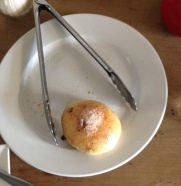 in January when I saw a sign at the
in January when I saw a sign at the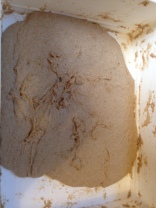 into actually making bread. Firstly we made a wholemeal dough, using RedBeard’s own leaven; this involved flour (1kg wholemeal, 200g rye, both stoneground) and water and salt and leaven, and then a lot of kneading. I love kneading; it’s wonderfully cathartic, and although it’s intensive I also found it lulled me with its rhythm. It looked like this, eventually. Very appealing, I think you’ll agree. It was way wetter than any of us (eight people on the day) had expected, which John – head baker and owner and teacher – stressed was incredibly important in creating a good sourdough.
into actually making bread. Firstly we made a wholemeal dough, using RedBeard’s own leaven; this involved flour (1kg wholemeal, 200g rye, both stoneground) and water and salt and leaven, and then a lot of kneading. I love kneading; it’s wonderfully cathartic, and although it’s intensive I also found it lulled me with its rhythm. It looked like this, eventually. Very appealing, I think you’ll agree. It was way wetter than any of us (eight people on the day) had expected, which John – head baker and owner and teacher – stressed was incredibly important in creating a good sourdough.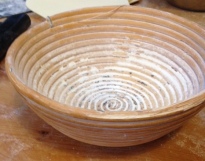 Then it had to rest for a while, so then we had a go at
Then it had to rest for a while, so then we had a go at  making a white sourdough with a dough that had been started a few hours beforehand by John’s sidekick. When John poured it out of the bucket, it reminded me of nothing else so much as the magic mud of my childhood (it’s all in the meniscus). With that dough we shaped cobs, using these awesome baskets that RedBeard has been using for however many years, and we made Vienna loaves, using their Belgian linen to make sure that the bread didn’t stick and stayed in shape.
making a white sourdough with a dough that had been started a few hours beforehand by John’s sidekick. When John poured it out of the bucket, it reminded me of nothing else so much as the magic mud of my childhood (it’s all in the meniscus). With that dough we shaped cobs, using these awesome baskets that RedBeard has been using for however many years, and we made Vienna loaves, using their Belgian linen to make sure that the bread didn’t stick and stayed in shape.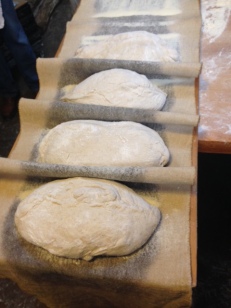 I think we then had lunch. To be honest, it all blurred together a bit – the order of things, that is – because it was a long day (10am to about 5pm). But I remember lunch very clearly, because it was amazing. There was bread, of course, with lashings of butter; and smashed roast potatoes and garlic; and a great salad with sprouts and lettuce and tomato and seeds; and a truly incredible free-form tart involving leek, goat’s cheese, roast capsicum, and other bits of deliciousness. The whole day was great but lunch was a really delightful moment of sitting down and appreciating food.
I think we then had lunch. To be honest, it all blurred together a bit – the order of things, that is – because it was a long day (10am to about 5pm). But I remember lunch very clearly, because it was amazing. There was bread, of course, with lashings of butter; and smashed roast potatoes and garlic; and a great salad with sprouts and lettuce and tomato and seeds; and a truly incredible free-form tart involving leek, goat’s cheese, roast capsicum, and other bits of deliciousness. The whole day was great but lunch was a really delightful moment of sitting down and appreciating food.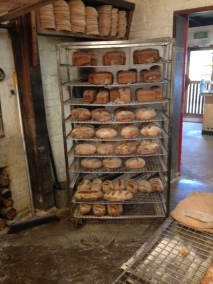 our household doesn’t eat THAT much bread, that’s not so bad.
our household doesn’t eat THAT much bread, that’s not so bad. I now have a list of things I think I need – at least some sort of basket for shaping the cob, because there’s just something about a cob that appeals more than the high tin, for me. I also need to put bricks into the bottom of the oven, in order to increase its thermal mass; this is apparently a good idea for any oven, since it keeps the heat in rather than letting it all whoosh out when you open the order. Happily my darling doesn’t seem to mind the idea.
I now have a list of things I think I need – at least some sort of basket for shaping the cob, because there’s just something about a cob that appeals more than the high tin, for me. I also need to put bricks into the bottom of the oven, in order to increase its thermal mass; this is apparently a good idea for any oven, since it keeps the heat in rather than letting it all whoosh out when you open the order. Happily my darling doesn’t seem to mind the idea.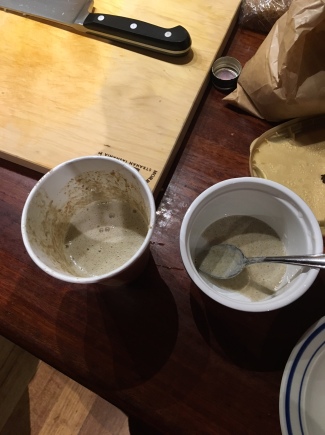
 of the bitterness. Then let them simmer in a heavy sugar syrup (1:1) for about an hour. Allow to drip for a day… or more… then roll in sugar and stuff into jars.
of the bitterness. Then let them simmer in a heavy sugar syrup (1:1) for about an hour. Allow to drip for a day… or more… then roll in sugar and stuff into jars. gingernuts before baking and that was a winner. Not sure where these will end up, as yet, but I anticipate they’ll keep pretty well.
gingernuts before baking and that was a winner. Not sure where these will end up, as yet, but I anticipate they’ll keep pretty well. this is the same batch of orange peel I can only assume that I did not sterilise this jar as well as I should. Which is a really shame, since I think they were going to be very tasty.
this is the same batch of orange peel I can only assume that I did not sterilise this jar as well as I should. Which is a really shame, since I think they were going to be very tasty. More birthday cupcakes! I’d been eyeing these off for a while but the ingredient ‘creamed coconut’ put me off because I had no idea what it was. I finally googled it and it’s just coconut butter/ oil – which I have, so that was easy. Interestingly, although they have both coconut butter and desiccated coconut, they ended up tasting more lime-y than coconut-y to me. They have lime zest in them, and I had a nicely sized kaffir lime on the tree so I used that. I’m not complaining about the taste – in fact I thought they were quite lovely (yes I make more than I give. Of course). I’ll be making these again – when I have limes to use, anyway.
More birthday cupcakes! I’d been eyeing these off for a while but the ingredient ‘creamed coconut’ put me off because I had no idea what it was. I finally googled it and it’s just coconut butter/ oil – which I have, so that was easy. Interestingly, although they have both coconut butter and desiccated coconut, they ended up tasting more lime-y than coconut-y to me. They have lime zest in them, and I had a nicely sized kaffir lime on the tree so I used that. I’m not complaining about the taste – in fact I thought they were quite lovely (yes I make more than I give. Of course). I’ll be making these again – when I have limes to use, anyway.